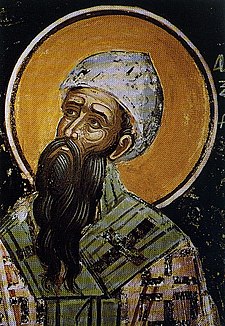
Back كيرلس الأول (بابا الإسكندرية) Arabic كيرلس الاول (بابا الاسكندريه) ARZ Cirilu d'Alexandría AST İsgəndəriyyəli Kirill Azerbaijani Kyrill vo Alexandria BAR Кірыл Александрыйскі Byelorussian Кирил Александрийски Bulgarian Ciril d'Alexandria Catalan Cyril Alexandrijský Czech Kyrillos af Alexandria Danish
Cyril of Alexandria | |
|---|---|
 St Cyril of Alexandria, Patriarch, and Confessor | |
| Archdiocese | Alexandria |
| See | Alexandria |
| Predecessor | Theophilus of Alexandria |
| Successor | Pope Dioscorus I of Alexandria |
| Personal details | |
| Born | c. 376 |
| Died | 444 (aged 67–68) Alexandria, Province of Egypt, Byzantine Empire |
| Sainthood | |
| Feast day |
|
| Venerated in | |
| Title as Saint | The Pillar of Faith; Seal of all the Fathers; Bishop, Confessor, Bishop of Alexandria, Teacher of the Faith and also (in the Catholic Church) Doctor of the Church |
| Attributes | Vested as a bishop with phelonion and omophorion, and usually with his head covered in the manner of Egyptian monastics (sometimes the head covering has a polystavrion pattern), he usually is depicted holding a Gospel Book or a scroll, with his right hand raised in blessing. |
| Patronage | Alexandria |
| Part of a series on |
| Catholic philosophy |
|---|
   |
| Part of a series on the |
| Eastern Orthodox Church |
|---|
| Overview |
| Part of a series on |
| Oriental Orthodoxy |
|---|
 |
| Oriental Orthodox churches |
|
|
Cyril of Alexandria (Ancient Greek: Κύριλλος Ἀλεξανδρείας; Coptic: Ⲡⲁⲡⲁ Ⲕⲩⲣⲓⲗⲗⲟⲩ ⲁ̅ or ⲡⲓ̀ⲁⲅⲓⲟⲥ Ⲕⲓⲣⲓⲗⲗⲟⲥ; c. 376–444) was the Patriarch of Alexandria from 412 to 444.[1][2] He was enthroned when the city was at the height of its influence and power within the Roman Empire. Cyril wrote extensively and was a major player in the Christological controversies of the late-4th and 5th centuries. He was a central figure in the Council of Ephesus in 431, which led to the deposition of Nestorius as Patriarch of Constantinople. Cyril is counted among the Church Fathers and also as a Doctor of the Church, and his reputation within the Christian world has resulted in his titles Pillar of Faith and Seal of all the Fathers. The Nestorian bishops at their synod at the Council of Ephesus declared him a heretic, labelling him as a "monster, born and educated for the destruction of the church".[3]
Cyril is well known for his dispute with Nestorius and his supporter, Patriarch John of Antioch, whom Cyril excluded from the Council of Ephesus for arriving late. He is also known for his expulsion of Novatians and Jews from Alexandria and for inflaming tensions that led to the murder of the Hellenistic philosopher Hypatia by a Christian mob. Historians disagree over the extent of his responsibility in this.
Cyril tried to oblige the pious Christian emperor Theodosius II (AD 408–450) to himself by dedicating his Paschal table to him.[4] Cyril's Paschal table was provided with a Metonic basic structure in the form of a 19-year lunar cycle adopted by him around AD 425, which was very different from the first Metonic 19-year lunar cycle invented around AD 260 by Anatolius, but exactly equal to the lunar cycle which had been introduced around AD 412 by Annianus; the Julian equivalent of this Alexandrian cycle adopted by Cyril and nowadays referred to as the "classical (Alexandrian) 19-year lunar cycle" would emerge a century later in Rome as the basic structure of Dionysius Exiguus’ Paschal table (AD 525).[5]
The Catholic Church did not commemorate Saint Cyril in the Tridentine calendar: it added his feast only in 1882, assigning to it the date of 9 February. This date is used by the Western Rite Orthodox Church. Yet the 1969 Catholic Calendar revision moved it to 27 June, considered to be the day of the saint's death, as celebrated by the Coptic Orthodox Church.[6] The same date has been chosen for the Lutheran calendar. The Eastern Orthodox and Byzantine Catholic Churches celebrate his feast day on 9 June and also, together with Pope Athanasius I of Alexandria, on 18 January. Cyril is remembered in the Church of England with a commemoration on 27 June.[7]
- ^ Cite error: The named reference
Chapmanwas invoked but never defined (see the help page). - ^ Chisholm, Hugh, ed. (1911). "Cyril (bishop of Alexandria)". Encyclopædia Britannica. 7. (11th ed.). Cambridge University Press. p. 706.
- ^ Gibbon, E., Milman, H. Hart. (1871). The history of the decline and fall of the Roman empire. A new ed., Phila.: J. B. Lippincott & co. Volume 4, p. 509.
- ^ Mosshammer (2008), pp. 193–194.
- ^ Zuidhoek (2019), pp. 67–74.
- ^ Calendarium Romanum (Libreria Editrice, 1969), pp. 95 and 116.
- ^ "The Calendar". The Church of England. Retrieved 27 March 2021.